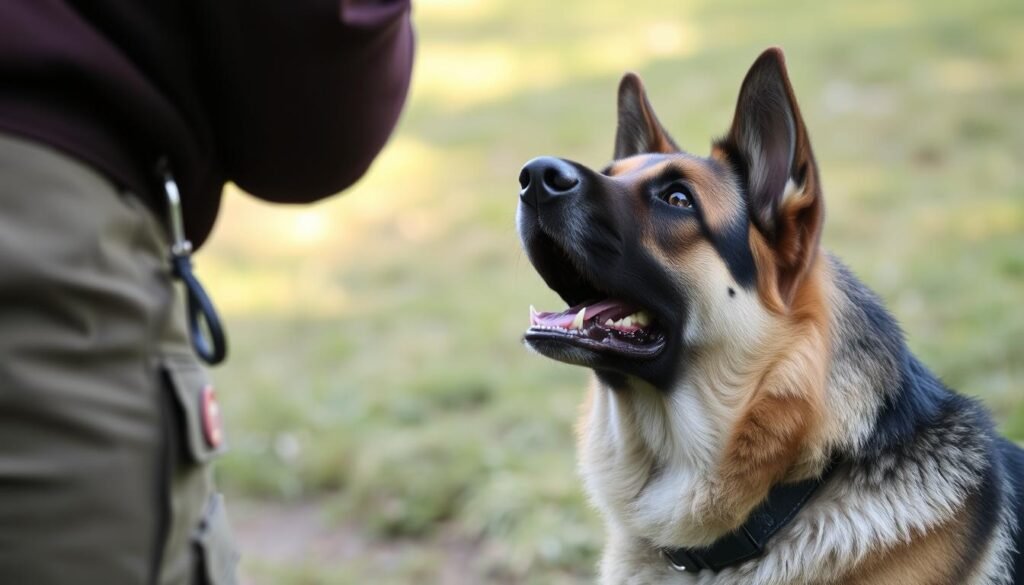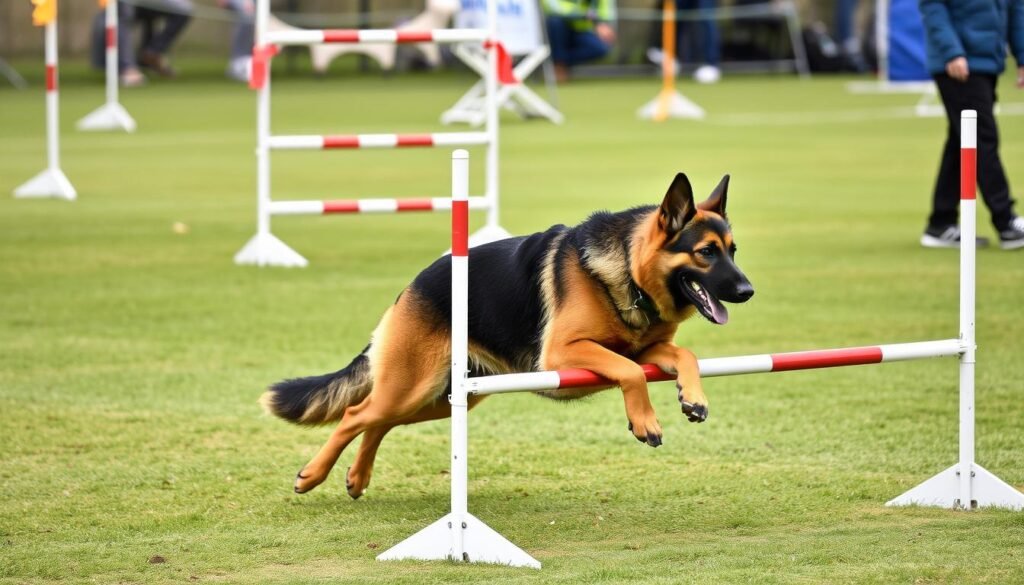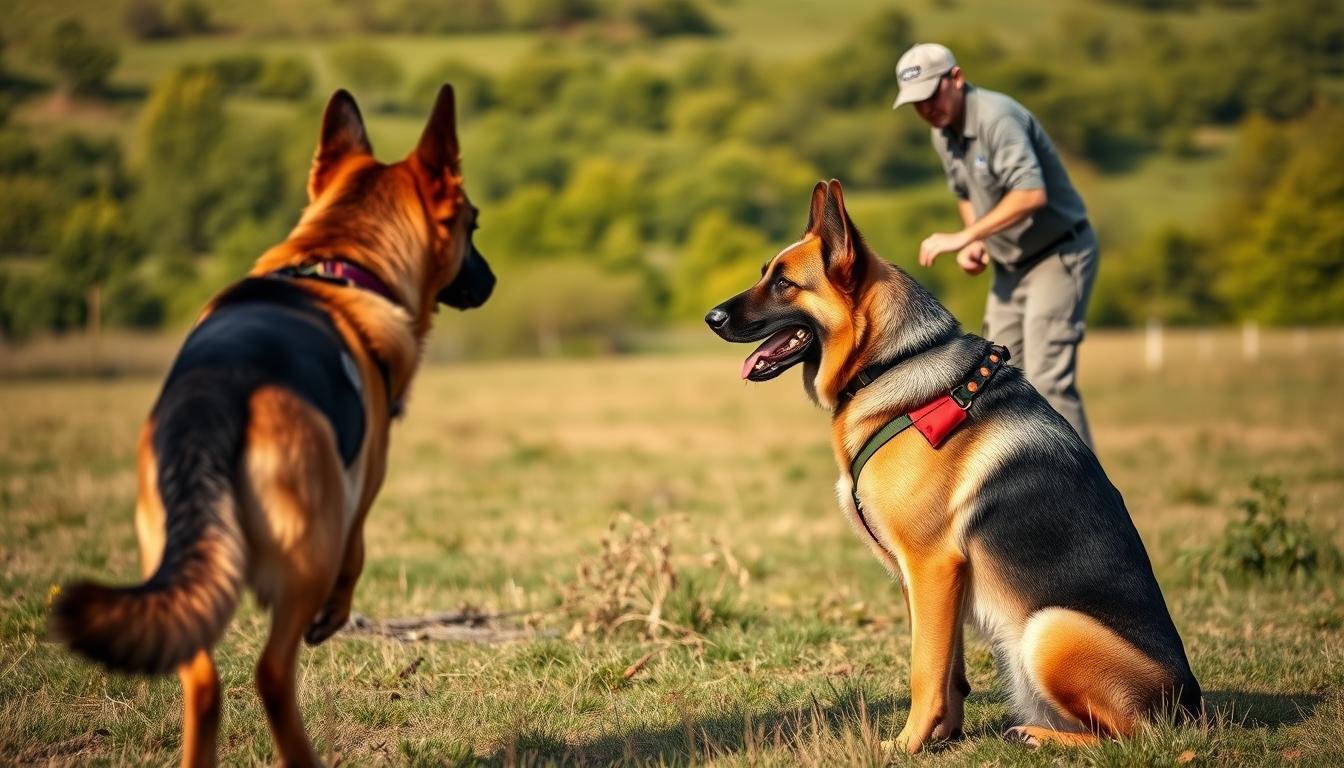The Best and Worst Training Methods for German Shepherds
Are you struggling to train your German Shepherd or wondering if you’re doing more harm than good? You’re not alone. Many dog owners face challenges when trying to train their pets, especially a breed as intelligent and energetic as the German Shepherd.
Understanding the right training methods for your Shepherd is crucial for developing a well-behaved, balanced companion.
This comprehensive guide will explore both effective and counterproductive training approaches specifically tailored to the German Shepherd’s unique temperament and needs.
Key Takeaways
- Discover the most effective training methods for your German Shepherd.
- Learn how to avoid common training mistakes that can damage your dog’s confidence.
- Understand the importance of tailored training approaches for German Shepherds.
- Find out how to harness your Shepherd’s intelligence and work ethic.
- Get practical, evidence-based training tips to bring out the best in your loyal companion.
Understanding German Shepherd Temperament
To train your German Shepherd effectively, you need to understand their unique temperament and personality traits. German Shepherds are known for their intelligence, loyalty, and protective nature, but these characteristics can manifest differently depending on the individual dog and its lineage.
Intelligence and Work Ethic
German Shepherds are renowned for their high intelligence and strong work ethic. They are highly trainable and thrive on mental and physical stimulation. As a breed, they excel in various roles, from police and military work to search and rescue, and competitive obedience. Their intelligence and willingness to please make them responsive to training, but they require consistent mental and physical exercise to prevent boredom and destructive behavior.
Protective Nature and Sensitivity
German Shepherds are naturally protective of their family and territory, which can sometimes be misinterpreted as aggression. However, with proper socialization and training, they can learn to differentiate between genuine threats and harmless strangers. They are also sensitive dogs that respond poorly to harsh treatment or punishment, requiring a gentle yet firm approach to training.
Working Line vs. Pet Line German Shepherds
The distinction between working line and pet line German Shepherds is significant. Working line German Shepherds are bred for their high drive, intense focus, and working capabilities, making them ideal for tasks like police work and protection sports. In contrast, pet line German Shepherds are bred for a more moderate temperament, making them better suited as family pets. Understanding whether your German Shepherd is from a working or pet line can help you tailor your training approach to their specific needs and temperament.
- Working line German Shepherds require more exercise, mental stimulation, and consistent training than pet line German Shepherds.
- Pet line German Shepherds are generally calmer and less intense, but still need regular exercise and training.
- Understanding your dog’s lineage can help you anticipate and address potential behavioral issues.
Why Training Is Essential for German Shepherds
Effective training is vital for German Shepherds to prevent behavioral issues and strengthen their bond with their owners. German Shepherds are not lazy dogs; they have significant physical and mental energy that needs to be channeled appropriately.
Preventing Behavioral Problems
Without proper training, German Shepherds may develop destructive behaviors due to their high energy levels and intelligence. Training sessions provide mental stimulation, which is as crucial as physical exercise in preventing boredom and related behavioral issues.
Consistent training helps prevent nuisance behaviors such as excessive barking, digging, and chewing. By engaging your German Shepherd in structured activities, you can redirect their energy into more productive and less destructive outlets.
Channeling Their Energy and Intelligence
You can use training to give your German Shepherd “jobs” that satisfy their need for purpose. Tasks such as retrieving items, carrying backpacks on walks, or participating in dog sports are excellent ways to channel their energy and intelligence. Even pet-line German Shepherds retain the working dog mentality and require daily mental challenges to prevent frustration and destructive behaviors.
Training that incorporates problem-solving elements not only satisfies their intelligence but also strengthens your bond through collaborative activities. By doing so, you’ll be providing your dog with the structure and mental stimulation they crave, ensuring a happier and healthier companion.
The Best Training Methods for German Shepherds

The key to successfully training your German Shepherd lies in understanding the most effective training methods. German Shepherds are highly intelligent and responsive to positive training techniques.
Positive Reinforcement Training
Positive Reinforcement Training is a highly effective method for German Shepherds. This approach focuses on rewarding desired behaviors rather than punishing undesired ones. By using rewards such as treats, praise, and play, you can encourage your German Shepherd to learn and obey commands.
Benefits of Positive Reinforcement: It fosters a positive relationship between you and your dog, reduces fear and anxiety, and promotes a more enjoyable training experience.
Clicker Training
Clicker Training is a specific type of positive reinforcement that uses a clicker to mark the exact moment a desired behavior occurs. This clear and immediate feedback helps your German Shepherd understand what you want them to do.
Clicker Training is particularly useful for shaping complex behaviors and can be a fun and engaging way to train your dog.
Reward-Based Training
Reward-Based Training expands on the principles of positive reinforcement by incorporating a variety of rewards that your German Shepherd values, such as play, praise, and access to activities. This approach is highly adaptable to individual preferences and is particularly effective for German Shepherds who are not food-motivated.
- Many German Shepherds are not particularly food-motivated, making traditional treat-based training less effective.
- You can identify your German Shepherd’s personal motivators and use these as rewards during training.
- Reward-Based Training that incorporates play satisfies both the mental and physical exercise needs of German Shepherds.
By understanding and applying these training methods, you can develop a well-behaved and loyal companion. Whether your German Shepherd is a puppy or an adult, the right training approach can make a significant difference in their behavior and your relationship with them.
Effective Leadership Training Approaches
Establishing a strong leadership bond with your German Shepherd is crucial for their training and development. Being a leader means being someone they can look to for guidance in challenging situations, who will take charge and show them the right way forward.

Clear Communication and Consistency
Clearly and consistently training your German Shepherd what you expect of them is vital. This involves holding them accountable to that standard in a calm, clear, firm but kind way, combined with lots of fun, rewards, and relaxation time when they get it right. Consistency is key to avoiding confusion and ensuring your dog understands what is expected.
Building Trust and Respect
Building a relationship based on mutual trust and respect is fundamental to successful German Shepherd training. Trust develops when your German Shepherd learns that you provide clear guidance, fair consequences, and protection in uncertain situations. You earn your German Shepherd’s respect through consistent, fair leadership that acknowledges their intelligence and sensitivity.
- A trust-based relationship allows your German Shepherd to look to you for guidance in new or challenging situations.
- German Shepherds who trust their owners are more confident in new environments and with new people.
- Building trust includes respecting your German Shepherd’s natural instincts and needs.
By adopting these leadership training approaches, you can develop a strong, trusting relationship with your German Shepherd, making them a willing partner in their training.
Early Socialization: A Critical Component
The importance of early socialization cannot be overstated, especially for protective breeds like German Shepherds. Socialization is extra important for guard breeds because they’re naturally more aloof and suspicious than happy-go-lucky breeds. It’s one of the keys to having a German Shepherd who can tell the difference between a normal person walking down the street and a potential threat.
Puppy Socialization Timeline
Puppy socialization is most effective when started early. The critical period for socialization is between 8 and 11 weeks old, but it should continue beyond this initial period. A well-planned puppy socialization timeline helps your dog develop into a confident adult.
- Expose your puppy to various environments and stimuli.
- Ensure positive experiences by pairing new encounters with treats and praise.
- Continue socialization throughout adolescence, as German Shepherds often go through a second fear period around 6-14 months.
Exposure to Different Environments and Stimuli
Your German Shepherd puppy needs controlled exposure to a wide variety of environmental stimuli, including different flooring surfaces, stairs, outdoor terrain, traffic sounds, and household appliances. This planned exposure helps your dog develop confidence in new situations rather than defaulting to suspicion or fear.
- Include meeting people of different ages, appearances, and behaviors.
- Create positive associations with new experiences.
- Shepherds who receive thorough environmental socialization are better able to distinguish between normal variations and genuine threats.
By focusing on early socialization, you can help your German Shepherd become a well-adjusted and confident companion, capable of handling various situations with ease.
Training Challenges Specific to German Shepherds
As a breed, German Shepherds present several training challenges that owners need to be aware of and address. Their natural guarding instincts, high energy levels, and aloofness with strangers can make training both rewarding and challenging.
Dealing with Protective Instincts
German Shepherds are naturally protective of their family and territory. To manage this instinct, it’s crucial to socialize them well and teach them to differentiate between real threats and harmless situations. Positive reinforcement training can help in channeling their protective nature into a positive trait.
- Socialization is key to managing protective instincts.
- Teach your German Shepherd to respond to commands in various situations.
- Positive reinforcement helps in developing a well-adjusted dog.
Managing High Energy Levels
German Shepherds are a high-energy breed that requires regular exercise and mental stimulation. Without adequate physical and mental activity, they can become destructive or restless. Engaging them in agility training or providing puzzle toys can help manage their energy levels effectively.
- Regular exercise is crucial for burning off excess energy.
- Mental stimulation through training or puzzle toys is essential.
- A tired German Shepherd is a happy and well-behaved dog.
Addressing Aloofness with Strangers
German Shepherds are often aloof with strangers, which can be misinterpreted as aggression. To address this, it’s essential to expose them to various people and environments in a controlled and positive manner. This helps them become confident and calm in the presence of strangers, reducing the likelihood of unwarranted aggression.
- Controlled exposure to strangers can help reduce aloofness.
- Positive experiences with different types of people are beneficial.
- Training should focus on polite behavior around strangers.
The Worst Training Methods for German Shepherds
Not all training methods are created equal, especially when it comes to intelligent breeds like German Shepherds. While these dogs are known for their loyalty and trainability, certain training approaches can be detrimental to their development and behavior.
Dominance-Based or Alpha Training
Dominance-based training methods, which focus on establishing the owner as the “alpha,” can be particularly harmful for German Shepherds. This approach often involves physical force, intimidation, and punishment, which can lead to fear, anxiety, and even aggression in dogs. German Shepherds are sensitive dogs that respond much better to positive reinforcement than to harsh, punitive measures. As a breed that thrives on pleasing their owners, they don’t require dominance-based training to behave well.
“The use of dominance-based training can damage the bond between dog and owner, leading to mistrust and behavioral problems,” says a renowned dog trainer. Positive, reward-based training methods are far more effective and foster a healthier relationship between you and your German Shepherd.
Punishment and Aversive Methods
Punishment and aversive training methods, which include techniques like yelling, physical punishment, or using devices that cause discomfort, are also counterproductive for German Shepherds. These methods can create anxiety and stress, potentially exacerbating behavioral issues rather than resolving them. German Shepherds are highly intelligent and respond well to reward-based training that encourages good behavior.

Aversive methods can lead to a range of problems, including fear-based aggression and avoidance behaviors. Instead, focus on rewarding desired behaviors to encourage a well-behaved and well-adjusted dog.
Inconsistent Training Approaches
Inconsistent training is particularly problematic for German Shepherds, whose intelligence allows them to quickly identify and exploit gaps in your training approach. Allowing behaviors sometimes but not others creates confusion and encourages your German Shepherd to test boundaries. To avoid this, establish clear rules that all family members consistently enforce. This consistency is essential for successful German Shepherd training and preventing the development of selective listening.
- Inconsistent responses to behaviors like barking or jumping up send mixed messages that make it difficult for your German Shepherd to understand what’s expected.
- German Shepherds thrive on predictability and clear expectations—inconsistency creates anxiety and confusion that can manifest as behavioral problems.
- You’ll find that German Shepherds quickly learn which family members enforce rules and which don’t, often behaving differently for different people based on their consistency.
Essential Commands and Skills to Teach
To ensure your German Shepherd becomes a well-behaved and obedient companion, it’s crucial to teach them essential commands and skills. A well-trained German Shepherd is not only a joy to be around, but it’s also safer for both the dog and those around them.
Basic Obedience Commands
Teaching your German Shepherd basic obedience commands is the foundation of their training. Commands like “sit,” “stay,” “down,” and “leave it” are essential for maintaining order and ensuring your dog’s safety. Consistency and positive reinforcement are key when teaching these commands. Use high-value rewards to motivate your dog and make the learning process enjoyable.
- Sit: Encourages your dog to remain calm and obedient.
- Stay: Helps maintain your dog’s position even when you’re not nearby.
- Down: Useful for calming your dog and maintaining control in various situations.
Impulse Control Training
Impulse control is vital for German Shepherds, as it helps them make better decisions and behave appropriately in different situations. Training exercises like “wait” and “leave it” can significantly improve your dog’s impulse control. Regular practice and gradual increases in difficulty will help solidify these skills.
Recall Training
Begin teaching your German Shepherd to come when called as soon as possible. A reliable recall is one of the most important safety skills you can teach your dog, potentially saving their life in dangerous situations. Here are some key points to remember:
- Start training in distraction-free environments with high-value rewards.
- Gradually progress to more challenging situations with increasing distractions.
- Never punish your German Shepherd for coming to you, as this can create negative associations.
- Use a special recall word or whistle associated with positive outcomes.
Recall training should be practiced regularly throughout your German Shepherd’s life, with periodic “refresher” sessions to maintain reliability even as your dog ages.
Advanced Training Options for German Shepherds
Once your German Shepherd has mastered basic obedience, it’s time to consider advanced training options that challenge their mind and body. Advanced training not only enhances your dog’s skills but also strengthens your bond and can help address behavioral issues.

Scent Work and Tracking
Scent work and tracking are excellent advanced training options for German Shepherds, leveraging their strong olfactory abilities. These activities provide mental stimulation and can be a fun way to engage your dog’s natural instincts. With proper training, your German Shepherd can excel in tracking and scent detection, making them a valuable companion in various environments.
Agility and Physical Training
Agility training is another advanced option that challenges your German Shepherd physically and mentally. It involves navigating obstacle courses that require speed, agility, and teamwork between you and your dog. This type of physical training is ideal for high-energy breeds like German Shepherds, helping to maintain their physical health and reduce boredom.
Protection and Guard Dog Training
For some owners, protection and guard dog training may be an appropriate advanced training path. However, it’s crucial that this training is undertaken with professional guidance and with dogs that have the right temperament and genetic predisposition. Protection training requires a dog with solid nerves and the ability to distinguish between threats and normal activities. It’s also essential that your German Shepherd has impeccable basic obedience and impulse control before starting protection training.
Common Training Myths About German Shepherds
The breed-specific characteristics of German Shepherds often give rise to training myths that need debunking. As a breed known for their intelligence and protective nature, it’s easy to see why misconceptions about their training arise. However, understanding the truth behind these myths is crucial for effective training.
Myth: They Need Harsh Training
One common myth is that German Shepherds require harsh training methods to become obedient. However, this couldn’t be further from the truth. Positive reinforcement training is not only more effective but also more humane. German Shepherds respond well to reward-based training, which encourages good behavior without inducing fear or aggression. By using positive reinforcement, you can build a strong bond with your German Shepherd and achieve better training outcomes.
Myth: They Can’t Be Trained Out of Guarding Behaviors
Another myth surrounding German Shepherds is that their guarding behaviors are hardwired and cannot be modified. This is not true; with proper training and socialization, German Shepherds can learn to differentiate between genuine threats and harmless situations. You can teach your dog to respond appropriately to common triggers like visitors or mail delivery through consistent training and clear boundaries. By doing so, your German Shepherd can become a discerning guardian, remaining calm in normal situations while still being protective when necessary.
Troubleshooting Training Problems
Troubleshooting training issues with your German Shepherd can be challenging, but understanding the root cause is key to resolving them. Training problems can arise due to various factors, including inconsistent training methods, lack of socialization, or underlying behavioral issues.
When Your German Shepherd Won’t Listen
If your German Shepherd isn’t responding to commands, it’s crucial to assess the training environment and your communication style. Ensure you’re using clear, consistent commands and positive reinforcement techniques. Sometimes, distractions or lack of focus can be the issue; in such cases, revisiting basic obedience training in a controlled environment can help.
Dealing with Reactivity Issues
Reactivity in German Shepherds can manifest as aggression or fearfulness towards people, other dogs, or stimuli. To address reactivity, it’s essential to identify triggers and gradually expose your dog to these triggers at a safe distance, rewarding calm behavior. Desensitization and counterconditioning techniques, under the guidance of a professional if necessary, can be highly effective.
When to Seek Professional Help
If training problems persist or if your German Shepherd exhibits severe behavioral issues such as aggression, persistent fearfulness, or destructive behaviors, it’s time to seek professional help. A certified professional dog trainer (CPDT) or a veterinary behaviorist with experience in positive reinforcement training can provide a customized training plan tailored to your dog’s needs.
Conclusion
By adopting a well-informed and compassionate training strategy, you can help your German Shepherd become a valued member of your family. The best training approaches leverage their intelligence and work ethic while respecting their sensitivity. Investing time in proper training during your dog‘s early years pays dividends in the form of a strong bond and reliable behavior. Avoid harmful methods like dominance-based approaches. With patience and consistency, your German Shepherd can become a trusted companion, enriching your life in countless ways.

